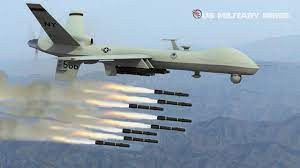A US Central Command investigation found the 29 August strike killed an aid worker along with nine members of his family, including seven children.
The youngest child, Sumaya, was just two years old.
US intelligence had tracked the man’s car for eight hours, believing it was linked to terrorist group IS-K, the Pentagon said.
The deadly strike was one of the US military’s final acts in Afghanistan, before ending its 20-year military operation in the country.
The inquiry found the aid worker’s car had been seen at a compound associated with IS-K, and its movements aligned with other intelligence about the terror group’s plans for an attack on Kabul airport.
At one point, a surveillance drone saw men loading what appeared to be explosives into the trunk of the car, but it turned out to be containers of water.
General Kenneth McKenzie described the strike as a tragic mistake and that it was “unlikely” the family was associated with ISIS-K or was a threat to US forces.
“It was a mistake and I offer my sincere apologies”, he said.
The strike happened as the aid worker – named as Zamairi Akmadhi – pulled into the driveway of his home, 3km (1.8 miles) from the airport.
The explosion set off a large secondary blast, which US officials initially said was proof that the car was indeed carrying explosives. However the investigation has found it was most likely caused by a propane tank in the driveway.
Relatives of the victims told the BBC that they had applied to be evacuated to the US, and had been waiting for a phone call telling them to go to the airport.
One of those killed, Ahmad Naser, had been a translator with US forces. Other victims had previously worked for international organisations and held visas allowing them entry to the US.
“It’s wrong, it’s a brutal attack, and it’s happened based on wrong information,” Ramin Yousufi, one of the relatives said.
He added, tearfully: “Why have they killed our family? Our children? They are so burned out we cannot identify their bodies, their faces.”
The strike happened as the aid worker – named as Zamairi Akmadhi – pulled into the driveway of his home, 3km (1.8 miles) from the airport.
The explosion set off a large secondary blast, which US officials initially said was proof that the car was indeed carrying explosives. However the investigation has found it was most likely caused by a propane tank in the driveway.
Relatives of the victims told the BBC that they had applied to be evacuated to the US, and had been waiting for a phone call telling them to go to the airport.
One of those killed, Ahmad Naser, had been a translator with US forces. Other victims had previously worked for international organisations and held visas allowing them entry to the US.
“It’s wrong, it’s a brutal attack, and it’s happened based on wrong information,” Ramin Yousufi, one of the relatives said.
He added, tearfully: “Why have they killed our family? Our children? They are so burned out we cannot identify their bodies, their faces.”
- Laker Men’s Basketball Handle Kuyper 88-55 - December 23, 2024
- MYWAY Sault Bridge Brawl & NEMWA Regional Results - February 22, 2024
- Crawford County Prosecutor clears State Trooper in the fatal shooting of man earlier this month - February 23, 2023




